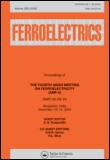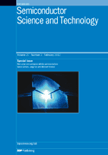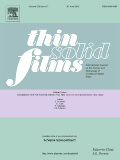
Transactions on Electrical and Electronic Materials
Scope & Guideline
Driving Progress in Electrical and Electronic Engineering
Introduction
Aims and Scopes
- Semiconductor Materials and Devices:
Research on the development, characterization, and optimization of semiconductor materials and devices, including transistors, diodes, and solar cells, emphasizing novel structures and materials. - Nanostructured Materials:
Investigation into the properties and applications of nanostructured materials, including nanocomposites and thin films, focusing on their electrical, optical, and magnetic characteristics. - Energy Materials and Storage:
Studies on materials related to energy conversion and storage, such as batteries, supercapacitors, and thermoelectric materials, highlighting advancements in efficiency and sustainability. - Sensor Technologies:
Exploration of various sensor technologies, including gas sensors, humidity sensors, and biosensors, with an emphasis on novel materials and fabrication techniques. - Computational Modeling and Simulation:
Utilization of computational methods to model and simulate the behavior of electrical and electronic materials, aiding in the design and optimization of devices. - Reliability and Degradation Studies:
Research focused on the reliability of electronic materials and devices, including degradation mechanisms under various operational conditions.
Trending and Emerging
- Perovskite-Based Technologies:
There is a significant increase in research focused on perovskite materials, particularly in solar cells and photodetectors, driven by their potential for high efficiency and low production costs. - Flexible and Wearable Electronics:
Emerging studies on flexible and wearable electronic devices are gaining traction, reflecting the growing demand for lightweight and adaptable materials in consumer electronics and medical applications. - Machine Learning Applications in Materials Science:
The integration of machine learning and artificial intelligence in materials research is on the rise, streamlining the design processes and predictive modeling of electronic materials. - Sustainable and Eco-Friendly Materials:
A growing emphasis on sustainable materials and processes, including biodegradable electronics and energy harvesting technologies, is emerging, aligning with global sustainability goals. - Advanced Sensor Technologies:
Research on advanced sensor technologies, particularly those utilizing nanomaterials and novel fabrication techniques, is trending upwards, driven by applications in environmental monitoring and healthcare.
Declining or Waning
- Conventional Dielectric Materials:
Research on traditional dielectric materials is declining as newer, high-k materials and novel composites gain traction for improved performance in electronic devices. - Basic Electrical Characterization of Bulk Materials:
The focus on basic electrical characterizations of conventional bulk materials is waning, with more emphasis shifting towards advanced nanostructures and composites. - Analog Circuit Design:
While still relevant, the volume of publications specifically centered on analog circuit design is decreasing as digital technologies and mixed-signal approaches become more prevalent. - Single Material Studies:
The trend towards single material studies is declining, as interdisciplinary and composite approaches are favored for their potential to yield enhanced performance and novel functionalities. - Traditional Photovoltaic Technologies:
Research specifically on traditional photovoltaic technologies is witnessing a decline, as emerging materials like perovskites and organic photovoltaics attract more interest.
Similar Journals

FERROELECTRICS
Fostering Collaboration in Materials ScienceFERROELECTRICS, published by Taylor & Francis Ltd, is a distinguished journal focusing on the multifaceted field of ferroelectric materials and their applications, encompassing aspects of condensed matter physics and electronic, optical, and magnetic materials. Established in 1970 and set to continue through 2024, this journal provides a critical platform for researchers, professionals, and students seeking to explore the latest advancements in ferroelectric phenomena. Although currently categorized in the Q4 quartile in key scientific fields, this journal serves as an invaluable resource for community knowledge sharing and collaboration, despite a competitive landscape evidenced by its Scopus ranks in both related domains. FERROELECTRICS remains committed to fostering innovation and understanding in materials science, providing seamless access to valuable research insights. As this journal continues to evolve, it aims to uplift its standing and broaden its impact in the scientific community.

IEEE ELECTRON DEVICE LETTERS
Connecting Research and Innovation in ElectronicsIEEE Electronics Device Letters, published by the esteemed IEEE-Institute of Electrical and Electronics Engineers Inc, stands at the forefront of innovation in the field of electrical and electronic engineering. With a rich history spanning from 1980 to 2024, this journal showcases groundbreaking research and letters that significantly contribute to the advancement of electronic, optical, and magnetic materials. Its impressive Q1 rankings in both Electrical and Electronic Engineering and Electronic, Optical, and Magnetic Materials underscore its pivotal role in shaping contemporary academic discourse. The journal maintains a strong position in Scopus rankings, positioned within the top 16% for Electrical and Electronic Engineering and the top 18% for Materials Science, making it a vital resource for researchers, professionals, and students alike. With the absence of open access, it maintains an exclusive repository of high-impact research that experts in the field turn to for the latest insights and developments. IEEE Electronics Device Letters is committed to providing a platform for the dissemination of transformative knowledge that fuels innovation and progress in the ever-evolving landscape of electronics.

Journal of Semiconductor Technology and Science
Connecting Minds in Semiconductor AdvancementsThe Journal of Semiconductor Technology and Science, published by the IEEK PUBLICATION CENTER, serves as a vital platform for advancing the field of semiconductor technology and materials science. With its ISSN 1598-1657 and E-ISSN 2233-4866, this journal has been pivotal since its inception in 2005, continuing to shed light on innovative research until 2024. Although currently classified in the Q4 category for both Electrical and Electronic Engineering and Electronic, Optical and Magnetic Materials, it remains a crucial resource for those in industry and academia alike, providing in-depth analyses and findings that explore the complexities of semiconductor applications. Researchers and professionals will find value in its comprehensive articles that address current trends and future directions in semiconductor technologies. This open-access journal, published in South Korea, is positioned to foster collaboration among students, professionals, and leading researchers in the ever-evolving technology landscape.

MICROELECTRONICS JOURNAL
Advancing the Frontiers of Microelectronics ResearchMICROELECTRONICS JOURNAL, published by Elsevier Sci Ltd since 1974, serves as a pivotal platform for disseminating cutting-edge research in the realms of microelectronics, nanotechnology, and materials science. With editions spanning from 1974 to 2024, the journal is well-respected within the scientific community, boasting a strong presence in key categories such as Atomic and Molecular Physics, Condensed Matter Physics, and Electrical and Electronic Engineering, as evidenced by its Q3 ranking in 2023. Researchers and professionals engaged in the exploration of electronic materials, optical applications, and nanoscale innovations can greatly benefit from the journal's insights, which situate their work within a robust academic framework. Although the journal does not currently offer open access, its rigorous peer-review process and high visibility in Scopus rankings—including a percentile ranking of 58th in Condensed Matter Physics—make it an essential resource for anyone looking to stay at the forefront of advancements in microelectronics and related fields.

SEMICONDUCTOR SCIENCE AND TECHNOLOGY
Illuminating the future of electronics with groundbreaking insights.Semiconductor Science and Technology is a pivotal journal in the fields of condensed matter physics, electrical and electronic engineering, and materials science, published by IOP Publishing Ltd. With an ISSN of 0268-1242 and an E-ISSN of 1361-6641, this esteemed journal has been disseminating groundbreaking research since 1986 and is set to continue through 2024. Recognized in the latest categorizations, it holds a notable Q2 ranking in Condensed Matter Physics, Electrical and Electronic Engineering, and Materials Chemistry, alongside a Q3 ranking in Electronic, Optical, and Magnetic Materials, highlighting its significant contribution to the advancement of these disciplines. Although it does not operate under an open access model, the journal provides critical access options for researchers and professionals seeking to foster innovation and collaboration within the semiconductor community. As a vital resource, Semiconductor Science and Technology not only supports the dissemination of high-quality research but also serves as a platform for emerging trends and developments that are shaping the future of semiconductor technology.

ECS Journal of Solid State Science and Technology
Bridging Theory and Application in Materials ScienceECS Journal of Solid State Science and Technology, published by the Electrochemical Society, is a prominent journal dedicated to the advancement of research in the field of electronic, optical, and magnetic materials. With an ISSN of 2162-8769 and an E-ISSN of 2162-8777, this journal has established a significant presence since its inception in 2012, spanning critical developments in solid-state science that are essential for innovative technologies. Operating within the United States and recognized for its global outreach, it holds a respectable Q3 category ranking in the materials science category as of 2023, reflecting its commitment to high-quality research and its role in bridging theoretical and applied aspects of materials science. Researchers, professionals, and students alike will find vital information and cutting-edge studies that further the understanding and applications of solid-state technologies. The journal is accessible to an extensive audience, making it an invaluable resource for those engaged in the ever-evolving landscape of materials science.

Journal of Ovonic Research
Advancing the Frontiers of Material Science.Journal of Ovonic Research is a distinguished publication dedicated to advancing the fields of electronic, optical, and magnetic materials. Published by VIRTUAL CO PHYSICS SRL, this journal offers a platform for researchers to share innovative findings and developments that push the boundaries of technology and materials science. With an ISSN of 1842-2403 and an E-ISSN of 1584-9953, it provides an important service to the academic community, particularly within Romania and beyond. Despite its recent inception in 2011, the journal has gained traction in the academic landscape, reflecting a Q4 quartile ranking in crucial categories such as Electronic, Optical and Magnetic Materials, as well as in Physics and Astronomy. The Scopus rankings further underscore its positioning, ranking within the 25th to 37th percentile across various disciplines, making it a valuable resource for professionals and students alike. Although the journal currently operates on a non-open access basis, it remains committed to exploring the latest advancements in materials science, encouraging interdisciplinary collaboration and fostering a deeper understanding of surface, coating, and film technologies. As the field evolves, Journal of Ovonic Research stands as a beacon for scholarly communication, bridging the gap between research and practical application.

Journal of Science-Advanced Materials and Devices
Unleashing Potential: Where Science Meets InnovationJournal of Science-Advanced Materials and Devices is a leading open-access journal published by Vietnam National University, dedicated to advancing the field of materials science through cutting-edge research and innovative developments. Since its inception in 2016, this journal has become a pivotal platform for sharing insights and discoveries in various subfields, including biomaterials, ceramics and composites, and electronic, optical, and magnetic materials. With impressive quartile rankings, including Q1 across multiple categories in 2023, and a notable Scopus ranking placing it in the top 15th percentile for ceramics and composites, it highlights the journal’s influence and prestige within the global academic community. Open Access since its launch, the journal aims to facilitate unrestricted dissemination of scholarly work, empowering researchers, professionals, and students to engage with the latest advancements. The Journal of Science-Advanced Materials and Devices is vital for those seeking high-quality contributions that influence both theoretical understanding and practical applications in the ever-evolving landscape of materials science.

Thin Solid Films
Pioneering Insights into Thin Film ApplicationsThin Solid Films, published by ELSEVIER SCIENCE SA, is a highly regarded journal in the fields of materials science and physics, specifically focused on the properties and applications of thin films. Established in 1967, this journal has been a leading platform for disseminating research on surfaces, coatings, and advanced materials. With its consistent publication through the notable HIndex of scholarly impact, this journal showcases a diverse range of studies ranging from electronic, optical, and magnetic materials to novel surface and interface engineering. In recent evaluations, Thin Solid Films has achieved significant rankings, including a Q2 position in Materials Chemistry and Metals and Alloys, reflecting its relevance and importance in ongoing scientific discourse. Although it does not offer open access, it provides a vital resource for researchers, professionals, and students seeking to advance their knowledge and expertise in thin film technology. The journal's commitment to quality and innovation makes it an essential publication for anyone engaged in the field.

Materials Letters-X
Pioneering Rapid Discoveries in Material ResearchMaterials Letters-X, published by ELSEVIER, is an esteemed open-access journal dedicated to the rapid communication of research in the fields of Condensed Matter Physics, Materials Science, Mechanical Engineering, and Mechanics of Materials. Launched in 2019, this journal has quickly established itself within the academic community, achieving Q3 quartile rankings in several categories according to the 2023 metrics. The journal's impactful contributions are reflected in its Scopus rankings, notably within Mechanical Engineering (Rank #308) and Mechanics of Materials (Rank #199). The open-access model promotes widespread dissemination and accessibility, ensuring that cutting-edge advancements in material science are readily available to researchers, professionals, and students worldwide. As it continues to grow, Materials Letters-X aims to inspire innovation and collaboration across disciplines, making it a pivotal resource for those engaged in material research and applications.